Malikjon Shermatov, Elyor Botirov, Muminjon Mukhammedov, Oygul Qayumova, Zulkhumor Mirzaeva, Gulshoda Sotvoldieva
Fergana State University, Uzbekistan
Copyright © 2021 The Author(s). Published by Scientific & Academic Publishing.
This work is licensed under the Creative Commons Attribution International License (CC BY).
http://creativecommons.org/licenses/by/4.0/

Abstract
The article presents the results of the first studies on distribution in the Fergana Valley of the butterflies of Sphingidae family. There are 5 species belonging to 4 genera of the subfamily Macroglossinae, 2 species of 2 genera of the subfamily Smerinthinae, and 1 species belonging to 1 genus of the family Sphinginae. Among mentioned above species 2 for Uzbekistan and 6 for the entomofauna of the Fergana Valley were recorded for the first time. One species (Smerinthus kindermannii) is found in the foothill zone of Southern Ferghana, 3 species (Proserpinus proserpina, Macroglossum stellatarum, Laothoe populi) in areas of the piedmont and lowland plain, 4 species (Hyles euphorbiae, Theretra alecto, Hyles zygophyllir, Agrius convolvuli) belonging to the family of revellers. Caterpillars of species such as Proserpinus proserpina, Macroglossum stellatarum, Hyles euphorbiae, Hyles zygophylli, Agrius convolvuli are found mainly in natural landscapes which feed on herbaceous plants. Caterpillars of such butterfly species as Theretra alecto, Smerinthus kindermannii, Laothoe populi can feed by spreading in cultivated landscapes. All 7 noted species of butterflies are locally distributed in ecosystems of the Fergana valley and are considered to be species in need of protection. Out of them only the population of Agrius convolvuli is relatively stable. The features of distribution, biology and ecology of butterflies of the family Sphingidae in Uzbekistan, particularly in the Fergana Valley are not well studied which dictates the need for comprehensive research.
Keywords:
Butterflies, Family sphingidae, Fergana valley, Caterpillars, Biology and ecology of butterflies
Cite this paper: Malikjon Shermatov, Elyor Botirov, Muminjon Mukhammedov, Oygul Qayumova, Zulkhumor Mirzaeva, Gulshoda Sotvoldieva, Distribution of Butterflies of the Family Sphingidae (Insecta, Lepidoptera) in the Fergana Valley, International Journal of Virology and Molecular Biology, Vol. 10 No. 2, 2021, pp. 27-33. doi: 10.5923/j.ijvmb.20211002.01.
1. Introduction
Most butterflies of the family Sphingidae (or revellers) are active at night, some species fly for short periods only after dark or at dawn, but other species can also fly during the day. The lifespan of these moths is 10 to 30 days. Their caterpillars feed mainly on leaves of trees and bushes, rarely on herbaceous plants. Due to the relatively limited food spectrum, they often feed on one or more related plant species during their life. Many species of the family Sphingidae are protected. However, some species can cause minor damage to horticultural crops and forestry. It is stated that worldwide from 1450 to 1700 species belonging to 206 genera of 3 subfamilies are found in this family [3,11,12,13,14,17]. There are 33 species of this family in the Central Asia and about 20 species in Uzbekistan [1].In some scientific sources on entomofauna of the Central Asia and the territory of Uzbekistan, there is information mainly concerning species of butterflies of economic importance, as well as species in need of protection [6,8,9]. Under conditions of the Fergana Valley, the species composition of insects belonging to this family has not yet been studied, which necessitates a comprehensive scientific research [18]. On this basis, we studied the distribution of representatives of the family Sphingidae by studying the territory of the Southern Fergana.
2. Material and Research Methods
In order to study butterflies of the family Sphingidae, entomological and generally accepted lepidopterological methods were used in the studies conducted in 2019-2021 [1,4,5,6,7]. Studies were conducted by the authors in the southern parts of the Fergana Valley in the territories of Kuva district - in the vicinity of the Karkidon Reservoir (40°27′03″N.L., 72°03′32″E.L.), Kuvasai city - in the Recreation Park (40°18′08″N.L., N, 71°58′28″E.L.), in the village of Chinortagi (40°18′06″N.L., 71°58′15″E.L.) as well as in Fergana region - in the villages of Vuadil (40°10′26″N.L., 71°43′39″E.L.), Satkak (40°24′41″N.L., 71°41′49″E.L.) and Chimion (40°15′27″N.L., 71°30′32″E.L.) (Picture 1). Butterflies were collected mainly in evenings, using a device with a night light, and during the day (mostly at dawn) with special nets [15]. 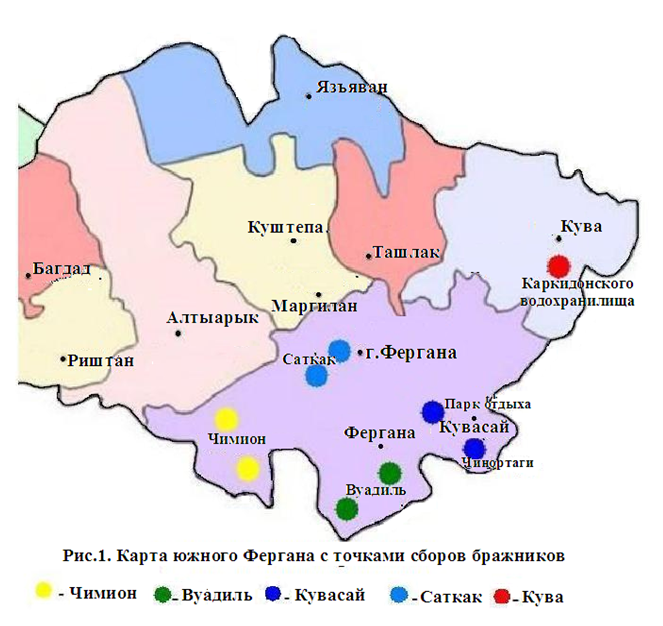 | Picture 1 |
A modern binocular microscope NLCD-307B was used to identify moth species and study their morphology. The moths were photographed by an expert photographer using a Canon EOS 5D Mark IV camera. Entomological guides and catalogues [5,12,13] were used to identify the materials collected at fixed sites. Samples of entomological research material and collected collection are stored in the laboratory of Experimental Biology at Fergana State University.
3. Results
As a result of the research in the southern areas of the Fergana Valley, 5 species of butterflies belonging to 4 genera of the subfamily Macroglossinae, 2 species of 2 genera of the subfamily Smerinthinae, 1 species of 1 genus of the subfamily Sphinginae of the family Sphingidae were recorded for the first time. Their characteristics are given below.Subfamily: MACROGLOSSINAE Harris, 1839 Genus: Proserpinus Hübner, 1819. This genus includes 8 species distributed in regions of North America, Africa, Europe, and Asia [12,13]. Among mentioned above species 1 species was first recorded in the Fergana Valley. Proserpinus proserpina Pallas, 1772 (Proserpina revisor). The species is distributed in Central and Southern Europe, the Crimea, Iran, Eastern Afghanistan, the Central Asia, Northwestern Africa, Northwestern China, the Caucasus and Western Siberia. Depending on the season, the range of this species extends from south to north of Europe [3,4,11,17]. The Proserpina reveller is listed in the Red Data Book of the Republic of Uzbekistan. It is noted that in Uzbekistan it occurs in the Zarafshan River basin valley [9]. In the Fergana Valley this species has not yet been studied, which requires comprehensive research. Place and time of occurrence: Near Kuvasay Recreation Park (04.05.2021) ♂1; territory of orchard in Chinortagi village of Kuvasay city (12.05.2021) ♂1.Foraging plant: Primula; Chamaenerion; Lysimachia; Onagraceae. Brief morphological description: The moth body length is 30 mm, forewings are 25 mm, hind wings are 15 mm, antennae are 15 mm. Width of wingspan when unfurled is 60 mm. Basic background of forewings is pale green to gray, transverse stripe crossing middle of body is dark green. There is a black spot on the upper edge of the band. The outer edge of the forewings has prominent notches and is darkly coloured at the edges. The hind wings are brown with a black transverse border on the underside. The outer margin of the hind wing is white (Picture 2). | Picture 2. Proserpinus proserpina Pallas, 1772 in projections from above (A) and below (B); Kuvasay city, 04.05.2021♂ (Original photo) |
Genus: Macroglossum Scopoli, 1777. Representatives of this genus include 80 species distributed in tropical and sub-tropical regions [17]. Among mentioned above species 1 species was recorded for the first time in the Southern Fergana as a new species for the entomofauna of Uzbekistan. Macroglossum stellatarum Linnaeus, 1758.The species is distributed throughout most of the Palaearctic region. The southern border of its range runs from North Africa through the Middle East, across Pakistan, to Southern China and Japan. In the southernmost part its range borders pass through Iran, Oman and the mountains of Algeria [12,13]. The northern borders of the range depend on climatic conditions which move annually. The species has not been studied in Uzbekistan, which requires extensive research.Location and time of detection: Fergana District, Chimion village, vicinity of orchard and clover field (01.06.2021) ♂1; (04.06.2021) ♂2.Forage plant: Galium; Stellaria.Brief morphological description: Body length of this moth is 26 mm, forewings are 20 mm long, hind wings are 14 mm long, the length of antennae is 11 mm long. Width of wingspan is 48 mm. Forewings are grey, covered with a transverse dark border; a fairly wide transverse band runs along the forewing, its colouring may vary from reddish, olive to green (Picture 3).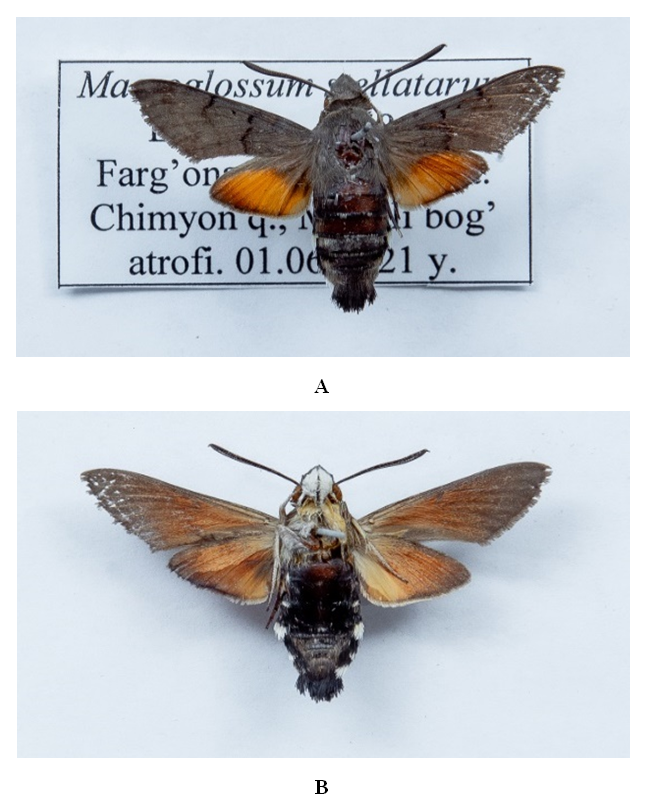 | Picture 3. Macroglossum stellatarum Linnaeus, 1758 in projections from above (A) and below (B); Fergana district, 01.06.2021♂ (Original photo) |
Genus: Theretra Hübner, 1819. This genus includes 69 species belonging to the Southern Palearctic region. Among mentioned above species 1 species was recorded for the first time in the entomofauna of the Fergana Valley. Theretra alecto Linnaeus, 1758 (Alecto moth). It is noted in literature that the range of the Alecto moth covers the regions of Southeastern Europe, Asia Minor and East Asia, India, Archipelago of Malaya and Sunda Islands, Philippines, the Caucasus, the Crimea, and the Central Asia [2,3]. There are data on occurrence of this species in Uzbekistan as a secondary pest of vineyards [6,8]. It is very expedient to carry out comprehensive studies on the peculiarities of distribution and development of the Alecto moth in natural and anthropogenic landscapes of the Fergana Valley.Place and time of detection: Kuva District, vicinity of the Karkidon Reservoir, orchard and vineyard (15.07.2019) ♂1.Forage plant: Vitis, Parthenocissus, Rubia, Gossypium.It is noted that the length of the forewings is 34 mm, the length of the hind wings is 22 mm and the length of the antennae is 15 mm. Width of the wingspan is 78 mm. Wings are long and pointed. Forewing is pale brown, shaded pink, with a black spot in the middle, some part from the second corner of the inner edge of the wing apex is extended and parallel to it there are several inconspicuous densely oblique stripes. Hind wings with burgundy levels, front and lateral edges dark brown with whitish inner corners ajar (Picture 4).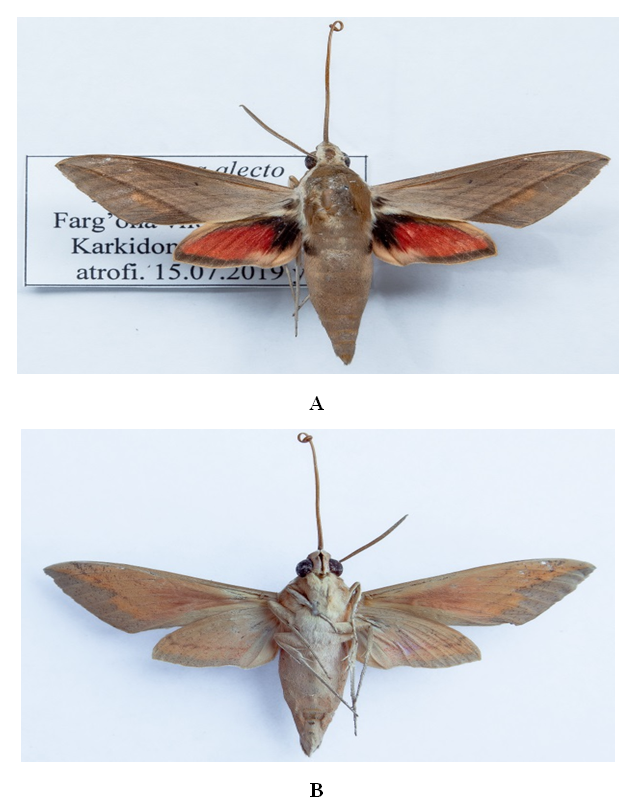 | Picture 4. Theretra alecto Linnaeus, 1758 in projections from above (A) and below (B); Kuva District, 15.07.2019 ♂ (Original photo) |
Genus: Hyles Hübner, 1819. This genus consists of 32 species, with subboreal-subtropical species distributed from Portugal and Spain to Western Mongolia. Representatives of this genus can be found in Lebanon, Israel, Jordan, Southern Turkey, Iraq, Iran, Turkmenistan, Uzbekistan, Kazakhstan, Kyrgyzstan, as well as in the Pamirs, Afghanistan and Mongolia [3,12,13]. Among mentioned above species 1 species was for the first time registered in entomofauna of Uzbekistan and 1 species in entomofauna of the Fergana valley. Hyles euphorbiae Linnaeus, 1758.Its range covers Southern and Central Europe, Asia Minor, Iran and the Eastern Afghanistan. However, it is also found in the Caucasus, the Urals, the Central Asia, Kazakhstan and the south of Western Siberia. It has also migrated to Karelia. There is information on the use of this species in the United States on the biological protection of invasive plants [10]. There is no information on the distribution and biology of this species in Uzbekistan in the scientific literature, therefore a comprehensive study should be carried out.Place and time of establishment: Near Satkak village in Fergana district (06.05.2020) ♀1; territory of pumping station in the vicinity of Chek-Shura mahalla (18.05.2021) ♂2.Forage plant: Euphorbia, Polygonum aviculare.Brief morphological description: The moth body length is 45 mm, forewing length is 40.5 mm, hind wing length is 25 mm. Width of wingspan is 91 mm. Length of antennae is 15 mm. There is a dark brown border at the base of the lower edge as well as on the middle of the forewing. Also conspicuous is a black spot at the base; the main background of the wing is cream-coloured. The base of the hind wing is black, with a dark transverse fringe running along the underside of the wing (Picture 5).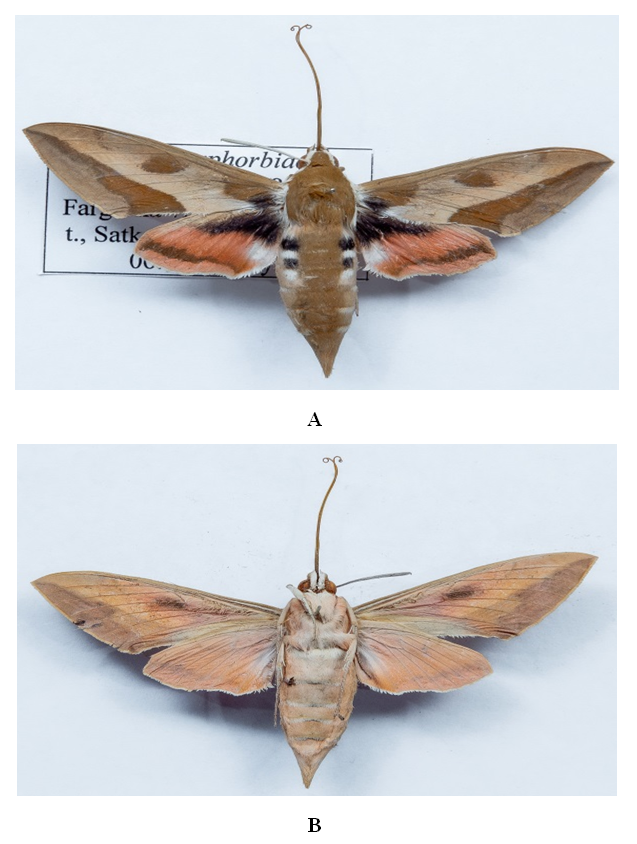 | Picture 5. Hyles euphorbiae Linnaeus, 1758 in projections from above (A) and below (B); Fergana District, 06.05.2020♀ (Original photo) |
Hyles zygophylli Ochsenheimer, 1808.The range of this species covers the south of Eastern Europe, the south-eastern regions of the European part of Russia, the southern and eastern parts of Turkey, Armenia, the Eastern Caucasus, Dagestan, the north of Syria and Iran, Central Asia and the north of Afghanistan. Pittaway (2021) provides brief information on the local occurrence of this species in Central Asian states, particularly in Uzbekistan [12]. The distribution and biology of this species in Uzbekistan has not been studied.Place and time of its occurrence: Near Satkak village in Fergana district (02.05.2021) ♂1; territory of the pumping station of Chek-Shura makhalla (14.05.2021) ♂1.Forage plant: Zygophyllum, Eremurus, Tribulus.Brief morphological description: Moth body length is 33 mm, forewing length is 26 mm, hind wing length is 16 mm. Width of wingspan is 60 mm. Antennae are 13.5 mm long. A white border runs along the middle of the forewings. Also conspicuous is a black spot at the base. Main wing background is pale brown. Base of hind wing black, with dark transverse border along the underside. Wing middle red, margins with white border (Picture 6).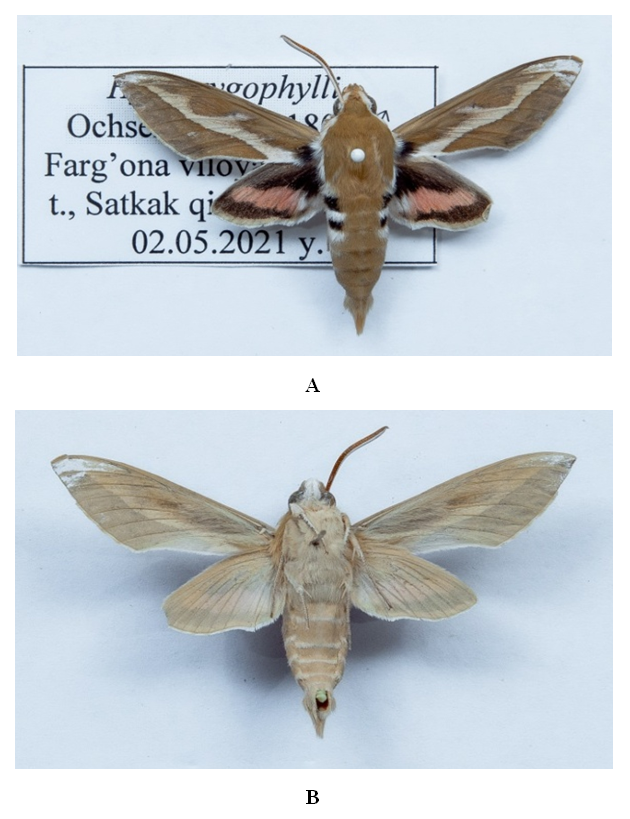 | Picture 6. Hyles zygophylli Ochsenheimer, 1808 in projections from above (A) and from the side (B); Fergana district, 02.05.2021♂ (Original photo) |
Subfamily: SMERINTHINAE Grote & Robinson, 1865.Genus: Smerinthus Latreille, 1802. There are 12 species belonging to this genus, all of them are distributed in Holarctic fauna. Of these, 4 species occur in the European region [3,11,13,14]. One species of this genus has been recorded for the first time in the Fergana Valley. Smerinthus kindermannii Lederer, 1857. This species is distributed in Turkey, Cyprus, and Lebanon in the west, occurring further east in Iraq, Iran, Afghanistan, and through Northern Pakistan to Kashmir. From there, it migrates from the north and north-east, spreading through Turkmenistan, Uzbekistan, Tajikistan, Kyrgyzstan and Kazakhstan to north-west China (Xinjiang, Ninghua, Gansu) [16,17]. The life cycle and distribution of the Kinderman's Moth in Uzbekistan is poorly studied. Place and date of observation: Fergana district, Chimion village, orchard area (06.06.2021) ♂1; Fergana district, Vuadil village, vicinity of the Recreation Park (11.06.2021) ♂1.Forage plant: Populus, Salix.Brief morphological description: Moth body length is 27 mm, forewing length is 26 mm, hind wing length is 15 mm. Width of wingspan is 60 mm. Antennae length is 14 mm. There is a whitish border from the base of fore wings (transversely) and along the edge of the upper part of the wing; the lower wing is reddish, with a black spot in the form of a semicircle in the middle of the lower edge. Hindwing margins are tinted to dark brown (Picture 7).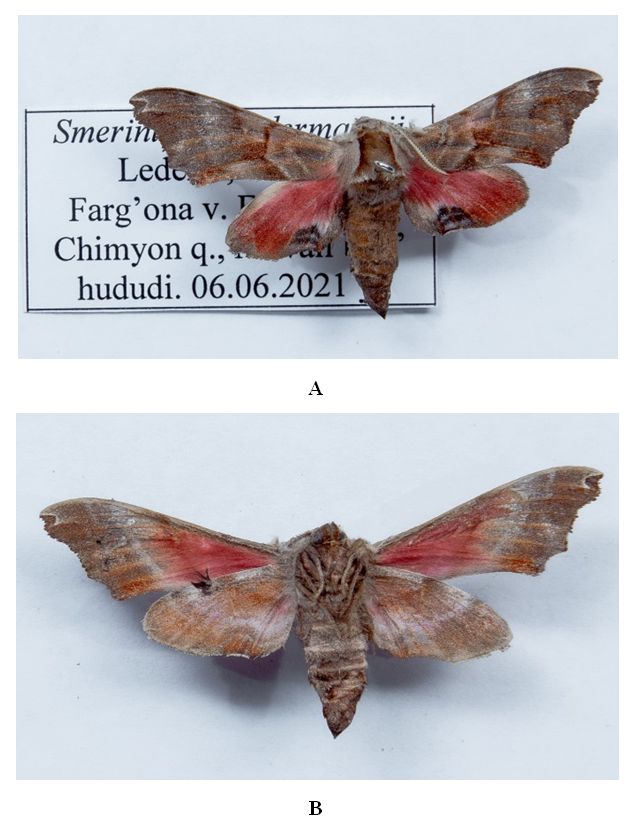 | Picture 7. Smerinthus kindermannii Lederer, 1857 in projections from above (A) and from the side (B); Fergana district, 06.06.2021♂ (Original photo) |
Genus: Laothoe Fabricius, 1807. This genus has 7 species that are distributed in the Palaearctic region. Among mentioned above species 2 species occur in the European region [12,14,17]. The caterpillars feed mainly on trees and shrubs in the willow family (Salicaceae). Pittaway and Kitching consider Laothoe populetorum (Staudinger, 1887) not as a separate species, but as a subspecies of Laothoe populi. 1 species of this genus was first recorded in the Fergana Valley. Laothoe populi Linnaeus, 1758. The range of this species covers Europe, the south of the Mediterranean Sea, Syria, Northern Iran and northwest China. At the same time, the electronic catalogue of the family Sphingidae by Pittaway (2018) notes that this species also occurs in the Caucasus, in the Central Asia, from the east of Western Siberia to Great Britain in the west [12,13]. The distribution and biology of this species in Uzbekistan has not been studied.Place and time of occurrence: Kuvasai town, Chinortagi village, vicinity of an orchard (20.07.2020) ♂2.Forage plants: Populus, Salix, Quercus, Crataegus; Cotoneaster, Malus.Brief morphological description: Body length of moth equals 41 mm, forewing length is 45 mm, lower wing length is 31 mm. Width of unfolded wingspan is 103 mm. Base of forewing pale brown with prominent wing veins. The base of the wing has a pale shade. There is a white spot in the middle. Base of hind wing reddish-brown, dominated by pale shade (Picture 8).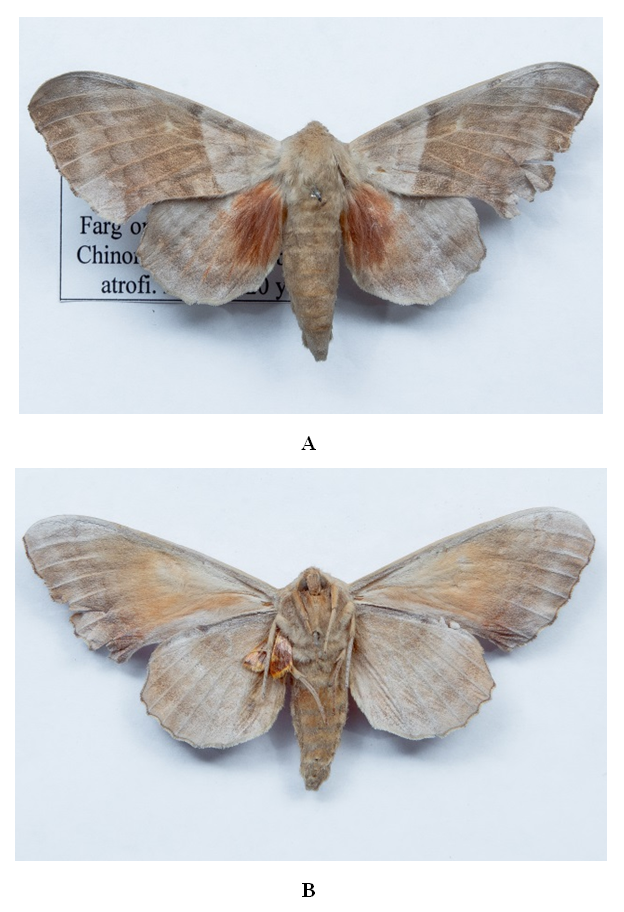 | Picture 8. Laothoe populi Linnaeus, 1758 in projections above (A) and laterally (B); Kuvasay City, 20.07.2020 ♂ (Original photo) |
Subfamily: SPHINGINAE Latreille, 1802Genus: Agrius Hübner, 1819. This genus has 6 species that are distributed throughout tropical and subtropical regions. The genus Agrius was described by the German entomologist Jakob Hübner in 1819. The caterpillars feed mainly on shrubs and herbaceous plants of the families Convolvulaceae, Fabaceae and Boraginaceae [12,14,17]. One species of this genus was first recorded in the Fergana Valley. Agrius convolvuli Linnaeus, 1758.Occurs only in the warmest areas of the western part of Palaearctic, but as a migrant covers almost the entire region. It is found in north of the European Russia, in the west to Ireland and the Azores. It is one of only three Sphingidae species recorded in Iceland. However, the electronic catalogue of the family Sphingidae (Pittavay, 2018) notes that the species also occurs in the Central Asia [12,13]. The distribution and biology of this species in Uzbekistan have not been studied.Place and time of occurrence: Fergana District, vicinity of Satkak village (03.07.2021 ♂1, 09.07.2021 ♂1).Forage plant: includes a wide range of plants from the families Araceae, Convolvulaceae, Leguminosae and Malvaceae.Brief morphological description: Body length of moth 48 mm, forewing length is 43 mm, lower wing length is 26 mm. Width of unfolded wingspan is 96 mm. Basic background of forewing light to dark grey with rectangular black spots at tip. The abdomen has a broad grey dorsal stripe, pink and black stripes bordered by white on the sides (Picture 9). | Picture 9. Agrius convolvuli Linnaeus, 1758 in projections from above (A) and from the side (B); Fergana district, 09.07.2021 ♂ (Original photo) |
4. Conclusions
As a result of the research, for the first time in entomofauna of Fergana Valley, 1 species of genera Proserpinus, Macroglossumi, Theretra, 2 species of genus Hyles of subfamily Macroglossinae, 1 species of genus Agrius of subfamily Sphinginae and 1 species of genera Smerinthus, Laothoe of subfamily Smerinthinae of family Sphingidae are registered. Butterfly species Smerinthus kindermannii Lederer, recorded in the foothills of Southern Fergana (Vuadil village), are not registered in other territories. Such species as Proserpinus proserpina Pallas, Macroglossum stellatarum Linnaeus, Laothoe populi Linnaeus are found in areas of adyrs (hills) and river valleys, and butterfly species Hyles euphorbiae Linnaeus, Theretra alecto Linnaeus, Hyles zygophylli Ochsenheimer, Agrius convolvuli Linnaeus inhabit areas below adyrs and lowland areas. Caterpillars of butterfly species such as Theretra alecto, Smerinthus kindermannii, Laothoe populi feed on leaves and buds of fruit, ornamental trees and shrubs, partly causing damage to orchard crops. Caterpillars of such species as Proserpinus proserpina, Macroglossum stellatarum, Hyles euphorbiae, Hyles zygophylli, Agrius convolvuli occur mainly in natural landscapes and feed on herbaceous plants.All 7 noted species of butterflies are locally distributed in ecosystems of the Fergana valley and are considered as species in need of protection. Only the population of the Agrius convolvuli butterfly is relatively stable.
References
| [1] | Азимов Д.А. и др. Насекомые Узбекистана. Под.ред. Азимов Д.А. –Ташкент: Фан, 1993. - 340 с. |
| [2] | Ефетов К. А., Будашкин Ю. И. Бабочки Крыма: (Высшие разноусые чешуекрылые). – Симферополь: Таврия, 1990. - 112 с. |
| [3] | Китчинг, И. Дж. Таксономический инвентарь Sphingidae (http://sphingidae.myspecies.info). Лондон, Великобритания: NHMUK, 2019. |
| [4] | Комаров Д.А. (очерк) Красная книга Волгоградской области. Т.1: Животные. Волгоград: Волгоград, 2004. 172 с. |
| [5] | Синёв С.Ю. (ред.). Каталог чешуекрылых (Lepidoptera) России. Издание 2-е. Санкт-Петербург: Зоологический институт РАН, 2019. 448 с. |
| [6] | Xoджаев Ш.T. Основы интегрированной защиты растений от вредителей и агротоксикологии.(на узб. языке) – Tашкент, 2014. - 540 с. |
| [7] | Шерматов М. Р., Ахмедов М. Х. Морфология тутовой огневки (Glyphodes pyloalis Walker (Lepidoptera, Pyralidae) // Узбекский биологический журнал. – 2002. – Т. 4. – С. 53-57. |
| [8] | Яхонтов В.В. Вредители сельскохозяйственных растений, сельхозпродукции Средней Азии и борьба против них (на узб. языке). –Tашкент: Средняя и высшая школа, 1962. – 696 с. |
| [9] | “Красная Книга” Республики Узбекистан - Tашкент: Chinor ENK, 2009. |
| [10] | Coombs, E. M., et al., Eds. Биологический контроль инвазивных растений в США. Corvallis: Oregon State University Press, 2004. – 254 p. |
| [11] | Pittaway, A. R. (1993): The Hawkmoths of the Western Palaearctic. Harley Books & Natural History Museum, London. ISBN 0-946589-21-6. |
| [12] | Pittaway, A.R. (2021). Sphingidae of the Western Palaearctic (including Europe, North Africa, the Middle East, western Siberia and western Central Asia). https://tpittaway.tripod.com/sphinx/list.htm. [Site accessed: July 05, 2021]. |
| [13] | Pittaway, A.R. & Kitching, I.J. (2021). Sphingidae of the Eastern Palaearctic (including Siberia, the Russian Far East, Mongolia, China, Taiwan, the Korean Peninsula and Japan). https://tpittaway.tripod.com/china/china.htm. [Site accessed: July 07, 2021]. |
| [14] | Scoble, Malcolm J. (1995): The Lepidoptera: Form, Function and Diversity (2-е издание). Издательство Оксфордского университета и Музей естественной истории в Лондоне, 1995. ISBN 0-19-854952-0. |
| [15] | Uzokov S. M., Shermatov M. R., Khomidova Z. M. Data on the Biology and Harmfulness of Pests (Insecta) of Apricot Trees in Western Fergana // TJM-Tematics journal of Microbiology ISSN. – 2021. – С. 2277-2952. |
| [16] | van Nieukerken; et al. (2011). "Order Lepidoptera Linnaeus, 1758. In: Zhang, Z.-Q. (Ed.) Animal biodiversity: An outline of higher-level classification and survey of taxonomic richness" (PDF). Zootaxa. 3148: 212–221. doi: 10.11646/zootaxa.3148.1.41. |
| [17] | Witt T.J., De Freina J.J. Die Bombyces und Sphinges der Westpalaearktis. Band 1. Edition Forschung & Wissenschaft Verlag GmbH, München. 1990. – 95 p. |
| [18] | Zokirov I. I. et al. Phytophagous insects of vegetable and melon agrocenosis of Central Fergana //International Journal of Agriculture, Environment and Bioresearch (IJAEB). – 2020. – Т. 5. – №. 02. – С. 64-71. |











 Abstract
Abstract Reference
Reference Full-Text PDF
Full-Text PDF Full-text HTML
Full-text HTML